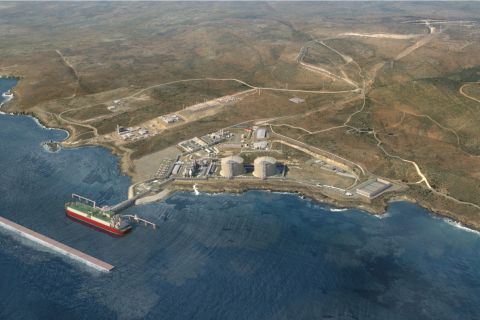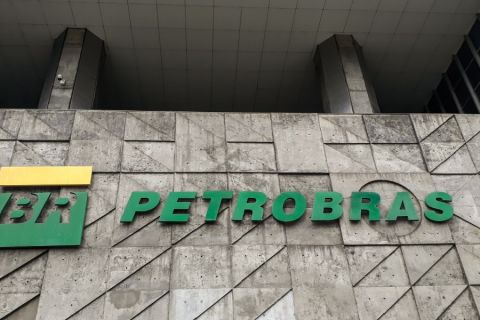Buoyant oil and gas prices add life to existing assets and create a strong market for companies that specialize in maintenance and construction upgrades to existing production operations around the world.
Zeffrey Lucas, president of PSN US Inc., a division of Production Services Network (PSN), said his organization could double its US business in the next 2 to 3 years. That’s both offshore and onshore, but the offshore portion will be a big contributor.
“We haven’t scratched the surface in the Gulf of Mexico,” he said. The company is off to a good start. Before May 1 last year, it had 650 employees. Now about 1,000 employees draw paychecks in the United States among the company’s 8,000 worldwide employees.
The company has a history stretching back over 30 years and was, until recently, part of the
 |
|
| The Terra Nova floating production, storage and offloading vessel collects oil offshore Newfoundland. (Photo courtesy of Petro-Canada) |
It went independent May 1 last year with a strong base in the North Sea and high aspirations for the rest of the world. “In the North Sea and in other parts of the world we provide the full scope of our services to our customers through integrated services contracts,” he said. Typically in the North Sea, after an operating company starts a platform and gets the operation running smoothly, it contracts out the maintenance and facilities modifications to a contractor.
Work
Now the company has a US $2 billion backlog and projects booked as far out as 2013.
Offshore operations are different from the company’s onshore projects, such as Occidental’s Elk Hills field complex in California. Offshore work has a smaller margin of error, Lucas said, because of potential time losses. Onshore, adjustments or scope changes can be managed on site. Offshore, they could hold up a job for days or weeks due to the complexities of the logistics.
Integrated companies often offer an advantage over individual contractors, he said. On Petro-Canada’s Terra Nova floating production, storage and offshore (FPSO) southeast of Newfoundland, for example, the company put together an integrated project team in October 2005 with PSN and Petro-Canada people. The goal was to design, engineer and fabricate a 40-person accommodation module and have it ready to lift when the FPSO entered dry dock in Rotterdam in July 2006.
Design and procurement started in December, and the first steel shipments arrived at the
 |
|
| The Hibernia platform was Canada’s first offshore production installation with first oil produced in 1997. (Photo courtesy of Hibernia) |
To increase speed and efficiency, both PSN and Pharmadule Emtunga, its Swedish subcontractor, stationed people at Bull Arm, while the company’s Newfoundland office worked on engineering with Emtunga.
The completed module left Bull Arm in June for the Keppel Verolme shipyard in Rotterdam and arrived on July 12, ready to lift onto the FPSO. That project took 8 months, about half the time of a typical job with those specifications, according to the service company’s Network magazine.
Sigma 3
An even greater example of flexibility and collaboration occurred when PSN, Amec and Wood Group joined parts of their organizations to form, in effect, equal shares in a new company called Sigma 3. That new entity signed an initial 7-year contract to handle integrated services for 15 Shell assets in the North Sea on a program that constituted an investment of nearly $1.48 billion for Shell, a program that was just too big for a single service company.
Lucas was general manager for that project, which became one of the biggest oil and gas entities in the North Sea with between 2,200 and 2,500 employees. “Sigma 3 was interesting. The only way to be successful was to work as ‘Sigma 3,’ not Wood Group, PSN or Amec. I ran it as an independent business,” he said. Among elements of that independent business, employees had to take pride in their work as Sigma 3 members, not specifically as employees of the three service companies.
Shell got the combined expertise of the three integrated service contract (ISC) companies acting as a single entity and didn’t need three engineering managers, three construction managers and three business managers.
As contractor with engineering and construction duties in collaboration with Shell, one of the projects meant connecting the subsea Scoter field back to Shell’s Shearwater platform in the central North Sea. That required the combined company to engineer and install a 200-ton module extension on the Shearwater production platform.
That’s typical of brownfield work, Lucas said. Operators design production facilities for peak production. As the reservoir depletes, the production parameters change and there is a need to modify the plant to optimize production through debottlenecking or adding to the facilities.
World reach
In the United Kingdom, the company secured the biggest contract in the North Sea last year for the provision of engineering, construction, operations and maintenance services to ConocoPhillips Central and Southern north Sea facilities. This extended a relationship which had been in place for 16 years for a further 5 years.
It joined the Hibernia project offshore Newfoundland in 1995, about 2 years before the platform began producing oil, and it has been there ever since. Engineering and construction work included all offshore modifications, among them the design, engineering, construction and commissioning of a cantilever deck to handle compression skids.
The Korean National Oil Company (KNOC) contracted the company to provide operations, support and maintenance on its Rong Doi and Rong Doi Tay (Twin Dragon and Twin Dragon West) gas fields offshore Vietnam. The service company will perform all operations and maintenance of the facilities on behalf of KNOC, including the provision of training and competency development for the national workforce, logistical support and engineering support services for modifications and major maintenance. The facilities include a wellhead platform bridge connected to a production, utilities, quarters and compression platform with condensate stabilization equipment. An adjacent floating storage and offloading vessel will take the condensate. The gas will be piped 38 miles (60 km) to the Nam Con Son pipeline to shore. The complex also treats water to required environmental standards for disposal into the sea.
Back in the North Sea, CNR International’s Ninian field showed the impact of effective work in mature fields. The field in blocks 3/3 and 3/8 offshore in the East Shetland Basin was discovered in 1974. It was developed with three structures, the Ninian Central platform with a concrete gravity base, the Ninian Southern platform with a steel jacket and 42 well slots, and the Northern platform with a steel jacket and 25 slots. To rejuvenate production from the complex, the service company helped design and install 20 new flowlines and six flowlines with electric submersible pumps (ESPs). That job required engineering, wiring for the ESPs, and control equipment and installation.
It installed a multiphase pump at the subsea manifold at Lyell field feeding the north platform and modified the platform to reinstate water injection in the field.
The company also is considering installing deck extensions for ESPs and variable-speed drives on the central and southern platforms. It is adding a number of integrity improvements and is involved in a study that could extend the life of the field to 2030.
With only some of the modifications in place, Ninian enjoys its best production in 5 years.
“We’ve been talking with oil companies here about improving their cost efficiencies and safety performance through the implementation of integrated service contracts in the Gulf of Mexico,” Lucas added at his Houston office. At present, operating companies typically do the design work in-house or through a number of contractors and farm out the engineering and construction work to others.
He anticipates more brownfield work in the Gulf of Mexico as high prices encourage operators to develop previously uneconomic smaller fields and modify their existing platforms for use
as regional hubs.
Recommended Reading
Marketed: Wylease Niobrara Shale Cloud Peak Opportunity
2024-04-30 - Wylease LLC has retained EnergyNet for the sale of working interest in the Niobrara Shale of Converse County, Wyoming in the Cloud Peak 3874-8-5-1NH.
Spate of New Contracts Boosts Technip’s Subsea Profits
2024-04-30 - TechnipFMC's operational profits are growing as the company heightened its focus on “quality” subsea orders, which earned $2.4 billion for the first quarter.
Marketed: Wylease Niobrara Shale Opportunity
2024-04-30 - Wylease LLC has retained EnergyNet for the sale of working interest in the Misty Moon Lake 3874-17-20-1NH of Converse County, Wyoming.
Permian Gas Finds Another Way to Asia
2024-04-30 - A crop of Mexican LNG facilities in development will connect U.S. producers to high-demand markets while avoiding the Panama Canal.
Petrobras Sending Nearly Half of Oil Exports to China
2024-04-30 - Conflict in the Middle East has enabled Brazil’s state-owned Petrobras to change the flow of its oil exports, with China being the primary beneficiary, followed by Europe.



